As found on Youtube. Featuring the IBM 3663 Supermarket Terminal.
And here’s a brochure on the IBM 3660 Supermarket System, as found on archive.org.
The Vintage Point Of Sale Site
Musings about our first generation of electronic point of sale equipment

As found on Youtube. Featuring the IBM 3663 Supermarket Terminal.
And here’s a brochure on the IBM 3660 Supermarket System, as found on archive.org.
I found this video on YouTube, it’s a “B” roll of news footage from a Target in Minnesota. Filmed in 1986, the first few minutes of the video feature the checkout area. This particular store was using IBM 3653 cash registers, assumedly in production for several years at this point. Target was using a mix of technology in the mid 1980s; newer stores used IBM 3683 cash registers at the time.
Watching the operator guidance panel when the cashier starts a new transaction. I’m assuming the user is cashier #16, then enters a “1” for “Cash Sale”, and then enters six digit SKUs and the price of each item.
I found a video on Youtube about the birth of the UPC code. Notice the IBM 3663 cash registers. I first saw these registers in use at Wegmans in the mid to late 1970s.
I stumbled across this video on YouTube from the Hagley Museum and Library channel. It is a very informative video on the IBM 5260 Retail Solution from the late 1970s and early 1980s.
A couple of interesting things about the cash register of this retail solution:
I had the opportunity to work on one of these registers for a mall photo shop in the 1991 or 1992. By that time the cash register was pretty beat up but still worked reliably. The new owner of the store needed assistance in learning how the register worked and what his upgrade paths were. Providing this information was a lot of fun for me, though I was learning about the register along the way as well. The majority of my IBM point of sale experience, up to that point, had been writing user exits on the IBM 4680 series of registers as a contract programmer.
Enjoy the video!
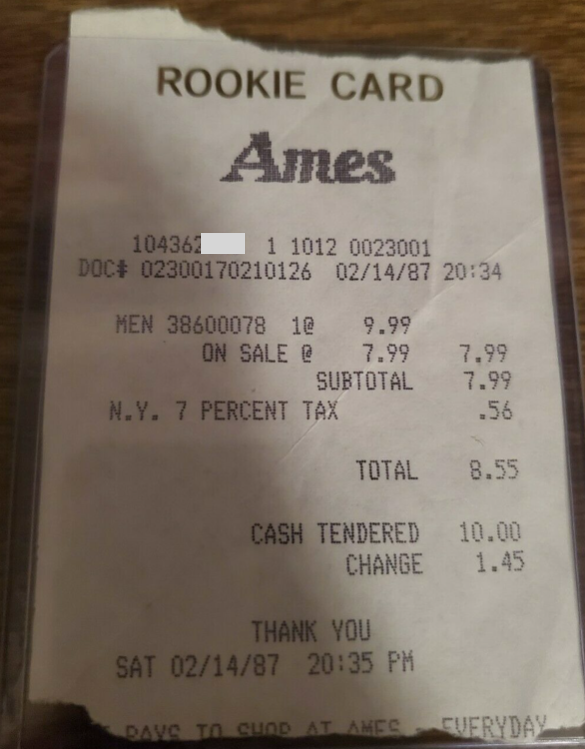
I stumbled across this receipt from Ames. it’s dated Valentine’s Day 1987. Click here to see the ebay Auction.
This receipt was generated by an IBM 3683 or 3684 register, running a later version of the Programmable Store Solution software Ames started out with in the early 1980s. The cashier entered the SKU and price and the register had the ability to know the sale price of that particular item (but not the selling price of all items).
The purchase was made at store #23 on register one. The lone “1” in the top row indicates this was a CASH-1 sale. Looking at the DOC #, I have never figured out with the “702” represents; the “6” at the end is a checksum digit.
For some reason I remember the tax line being right justified with “SUBTOTAL” and “TOTAL; I wonder if that changed with the later version of software.
I’d be curious to know where store #23 was.
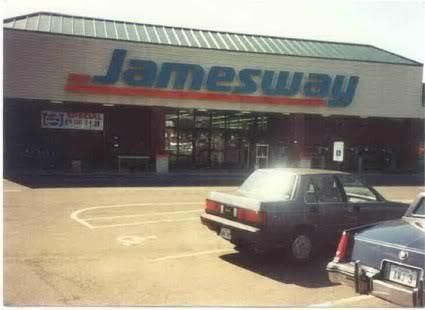
I didn’t step foot into a Jamesway until 1980. I was 11 years old at the time as I believe it was spring 1980. It was grand opening week of the Jameway store in Oswego, New York.
Prior to this grand opening week I had known this location, and another store on Arsenal Street in Watertown, N.Y. as “Welcome to the Wonderful World of Westons”, as the sign proclaimed as you walked into Westons Department Store.
Westons was a regional chain in Upstate New York that went bankrupt and was sold to Jamesway in late 1979.
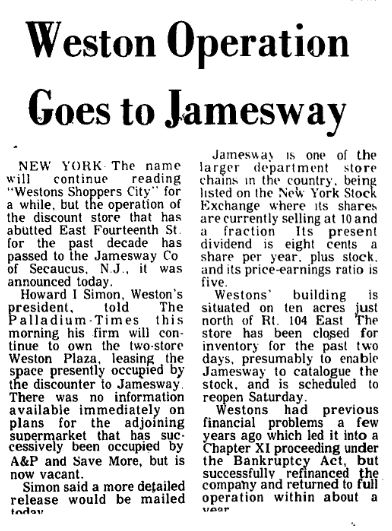
I remember both the Oswego and Watertown Westons stores having Sweda cash registers with inventory recording capabilities, using the punch tape method found at other department store chains such as Ames and Zayre. After my hometown’s Ames opened I paid closer attention to the Sweda registers at Westons, they worked the same way except they used two-digit department numbers instead of the three-digit class numbers used at Ames. I don’t remember if Westons had the “double-pass” numbering of certain items, where the cashier entered a merchandise number without an amount and then followed with the department number and the amount of the item being purchased. I do, however, remember that some of the Sweda registers at Westons were “Power Penny” machines, where the cents row of amount keys could all trigger the motor, whereas others were not and the cashier had to hit the big black motor bar after hitting the department and amount keys.
When Jamesway opened up in the Westons locations in both Oswego and Watertown, they used the same registers Westons had left behind. This was easily discerned by the fact that the receipts had a blob of ink where the Westons store branding had once appeared and you could vaguely make out the word “Westons”, as if the logo stamp had been covered over with tape.
Original Jameway stores opened up in the 1970s used NCR Class 5 cash registers at the checkouts. The last mechanical cash registers made by NCR, they were also the most sophisticated. Like the Sweda registers used at the former Westons stores, the NCR Class 5 registers punched an optical tape to be read by IBM mainframes located elsewhere. Here’s a Jamesway receipt from an NCR Class 5 register.
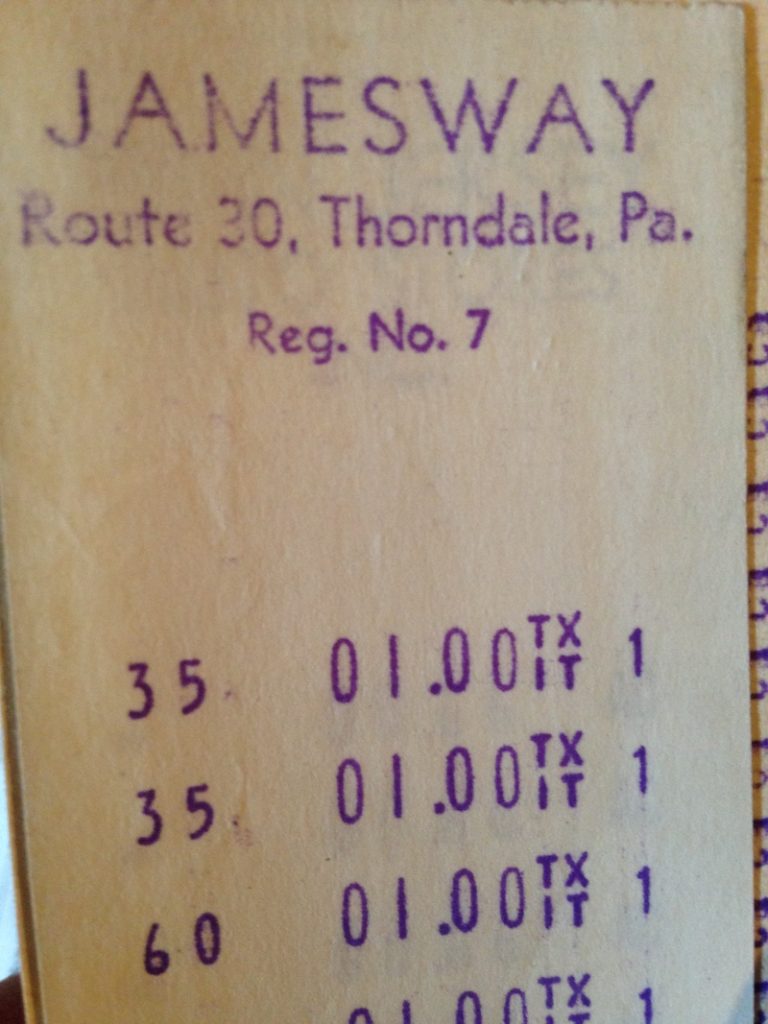
Jamesway used two digit department numbers and it wasn’t long before the stores were converted to the IBM 3680 Programmable Store System. I have been racking my brain trying to remember if Ames switched first and Jamesway followed or vice-versa. I’m inclined to think that Jamesway made the move to IBM 3683/3684 registers, but they used the lower model keyboard. There were fewer buttons on the keyboard and the “0” key was to the left of the numeric keypad instead of under the 1-2-3 row. The slash key was located above the zero key, adjacent to the 7-8-9 row.
After the move to the IBM system, Jamesway’s receipts showed a two digit number, followed by a slash mark, followed by the SKU, and then the amount. I intently watched a cashier input this information during a sale, trying to determine if they used the slash key for this input and they did not. There was a department and a separate SKU key to the right of the numeric keypad. The best I can tell, the version of the IBM software they were using was almost identical to the earlier IBM 3650 Retail Store System which ran on older IBM 3651 registers.
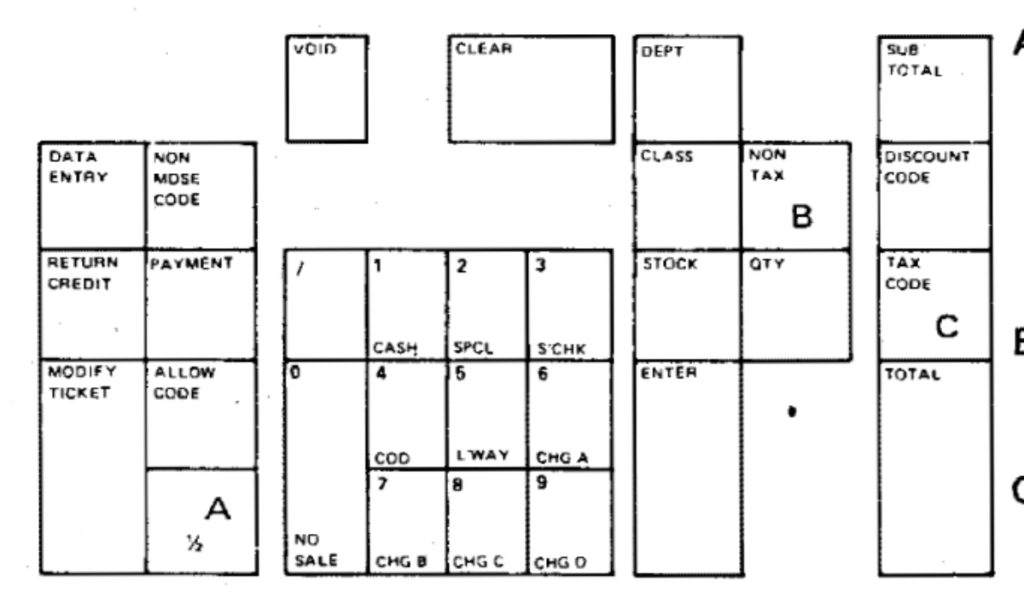
Having never been in a non-Westons Jameway before the opening of these locations in Upstate New York, I have no way of knowing if Jamesway may have been running the older IBM systems in their legacy stores.
When I was in college in 1986 I visited the relocated Jamesway store #1 in Lakewood, New York. Jamesway #1 had originally been further out Fairmount Avenue before relocation. Situated in the former JCPenney space in the Chautauqua Mall, this new location too ran the IBM 3683 registers I had seen replace the Sweda registers in Oswego and Watertown. Like those stores, that incarnation of Jamesway #1 was running with the lower model keyboard on the 3683s. I can not find a receipt from this implementation anywhere on the Internet.
About 10 years ago I found some photos from a Jamesway store that were taken in the late 1970s. The store featured in the photo series was using NCR Class 5 mechanical registers with department number keys, just as Ames did when they took over Big N in the late 1970s. I am still trying to locate those photos.
In the late 1980s Jamesway moved to the IBM 4683/4684 registers, however, it appears they did not use the IBM 4680 Retail Application software, but instead went with a system from PSI in Raleigh, North Carolina. The use of PSI software is a theory; I determined this by the format of the receipt issued from the IBM 4683, it bears no resemblance to a receipt from IBM 4680 Retail Application, not even with heavy modification.
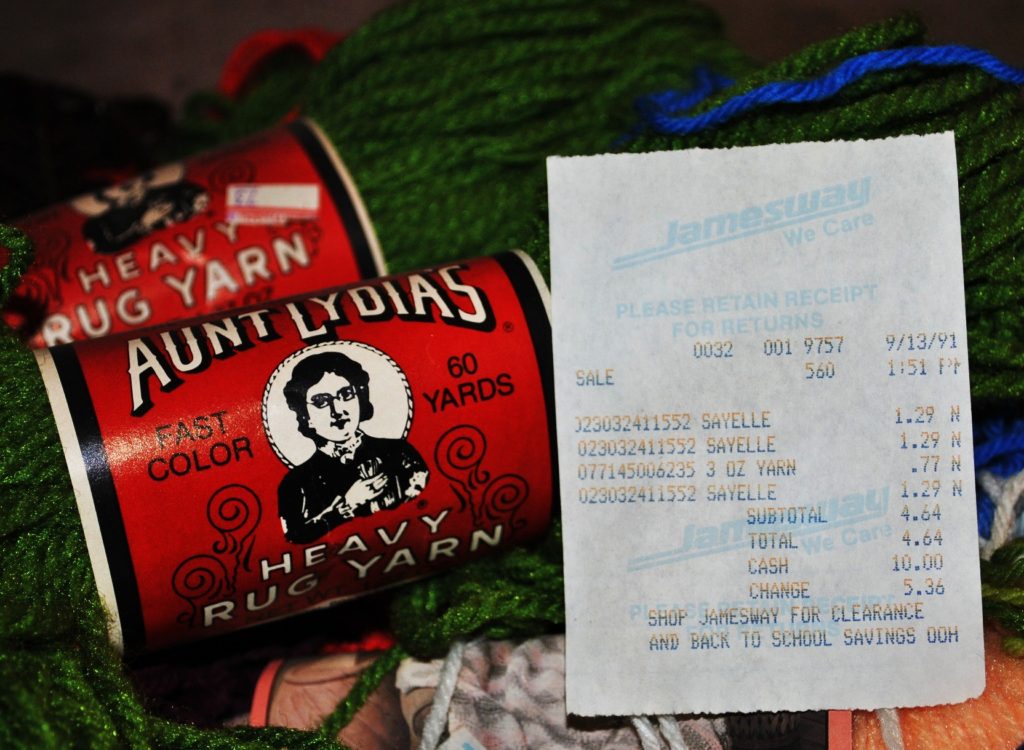
The receipt’s formatting is identical to receipts from other chains that used PSI’s software on Fujitsu cash registers. PSI was later purchased by Fujitsu.
With the implementation of the IBM 4683/4684 registers up front, Jamesway introduced scanning to their stores, hence the UPC code on the receipt. Having done some contract programming on IBM 4680 systems and having actually used the software during some holiday cashier duties for other chains, when I watched a cashier at Jamesway work through a transaction on an IBM 4683 at a store in Oneida, New York I knew there was no way they were using IBM’s Retail Application.
Jamesway declared bankruptcy and closed up shop in 1995. I missed the opportunity to purchase one or two of the registers from their liquidation sales. I have fond memories of the chain and always had a pleasant experience in their stores.
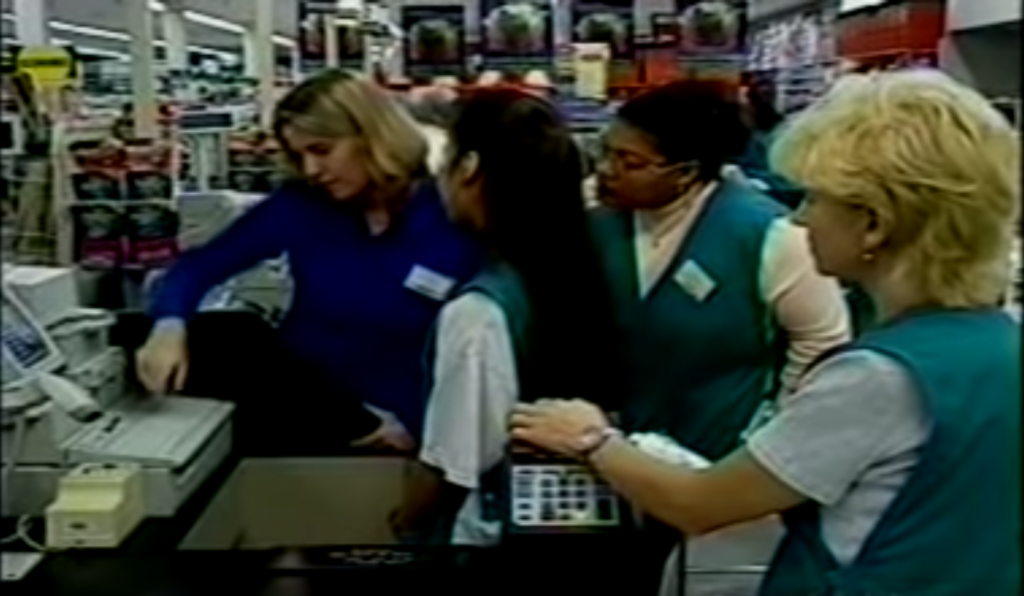
In 1997 or so, Ames decided it was time to move to the next stage of their point of sale technology implementation. By this time the IBM 3680 hardware, running the AWare/4680 modifications, had been in the legacy Ames stores for well over a decade, and the IBM 4680 hardware in the former Zayre stores were nearly a decade old as well. With murmurs of Y2K on the horizon, Ames moved forward and decided to upgrade their point of sale equipment with a unified approach, tying their front end systems in with their back-end systems.
Ames decided not to continue with IBM’s General Sales Application and instead went with Cornell-Mayo Associates of New Jersey and their OPUS Store System package.
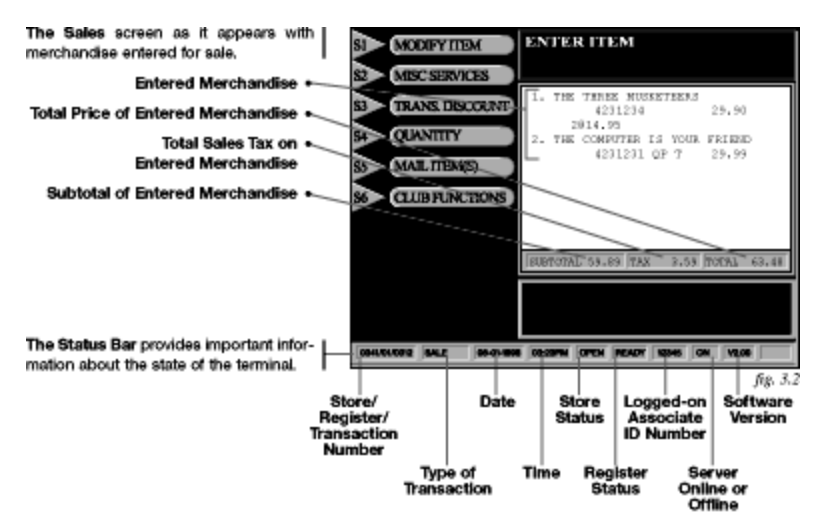
Working with Cornell-Mayo, Ames installed Siemens-Nixdorf hardware for their point of sale systems. The cool thing about CMA’s OPUS Store System Package was that it could run on pretty much any hardware configuration at the time. If the terminal had enough horsepower it would run with a graphical interface. An older terminal could have its life extended and would run OPUS in a text-only interface. The approaches to the system used the same keystrokes, commands, and workflow, so an operator would feel comfortable in front of either type of terminal. CMA’s OPUS Store System also ran on any architecture, meaning it could run from a Windows NT terminal server or it could run on Unix or Linux.
When Ames made the switchover from AWare/4680 to the OPUS Store System I lived near a former Zayre store in New Hartford, New York. Unlike the day back in the early 1980s when I saw the folks removing the old Sweda cash registers and replacing them with IBM 3683 terminals, I did not get to see any of the switch over at this store in New Hartford. I did know folks that worked at the store, and in our brief conversations about the store (and my interest and history I had with Ames and its point of sale systems), they mentioned they really liked the upgrade of the point of sale systems and they were happy they could scan in the receipt number instead of punching all those numbers in while working at the service desk.
It’s the little things that make our jobs easier, right?
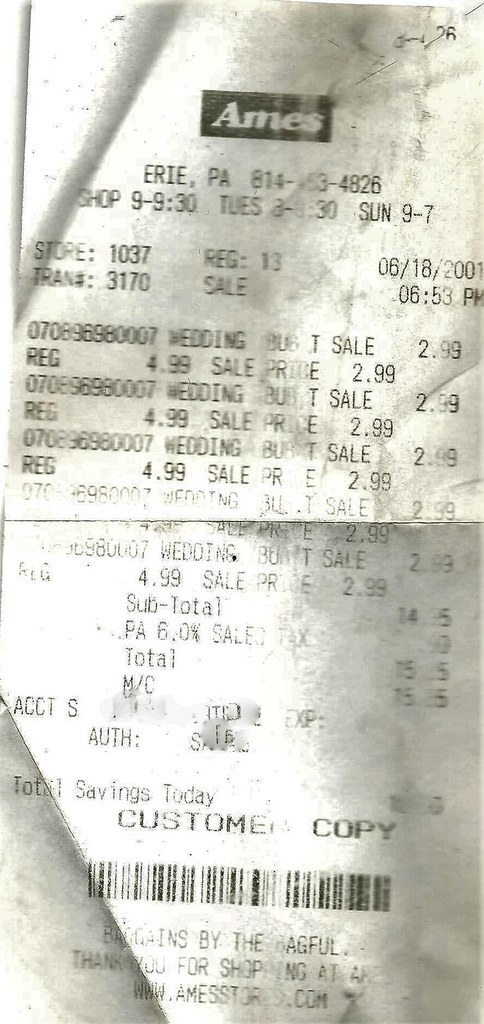
With the move to the CMA system, Ames was now printing the UPC code along with the item description on their receipt. Functions were controlled through “S” keys on the keyboard (S1, S2, S3, etc), which would map to functions as dictated by the user interface, depending on where we were at any given point of a transaction. The thermal printers printed the receipts quickly and the Ames logo was back loud and proud at the top of every receipt!
Ah, but what about the eight-digit SKUs that had endured for so many years with the IBM systems? They made their way to the backend database, and if an item didn’t scan for whatever reason and the UPC wasn’t to be found in a manually keyed in lookup, the cashier could enter the eight digits and the press the SKU button, which was located right where it was on the old IBM systems, to the right side of the keyboard adjacent to the “789” row and the function key row above it.
Curious about these new systems, I sent email to the Ames MIS department back in Rocky Hill, Connecticut and had a really nice email exchange with the team responsible for installing and maintaining this new point of sale system. Markdowns and sales were easier to maintain, the system used standard hardware, and all aspects of the store’s business was connected and communicating with each other and with the home office.
Ames was ahead of the Y2K curve.
A quick side note, the IBM 3683 terminals in the legacy Ames stores probably would have struggled with the year 2000. Another retail chain was still using IBM 3683s well into 2001. Receipts from after the Y2K scare were dated 1972 to compensate.
In late 1998 Ames purchased the Hills Department Stores chain. At the time Hills was operating 155 stores, all on the IBM 4680 OS system running General Sales Application, or some customized variant of it. The acquisition resulted in duplicate Ames stores in some towns. Where I went to college in the mid 1980s there a legacy Ames store, an acquired Zayre store that also became Ames, and then eventually the legacy Ames store was shut down, however, there was a Hills across from the Zayre-turned-Ames, and one of them had to go. I believe it was the former Zayre that was closed down.
There were no Hills in the Mohawk Valley of Upstate New York, but there was a Hills near my hometown. This Hills was in the now long gone Penn Can Mall and it was converted to an Ames. The company handled this transition differently in that they shut the Hills down completely and quickly remodeled the store with a new green-and-black scheme, and then opened up as Ames with a grand opening celebration.
Like the day when Ames #80 opened up in the late 1970s, I attended the grand opening of this new Ames at Penn Can Mall, and was surprised to see not Siemens-Nixdorf registers at the check stands but rather IBM SurePOS terminals. Thinking Ames had gone the “Zayre conversion route” again with their point of sale systems, I was happy to see that Ames had done it the right way, and while this converted Hills may have been running IBM SurePOS registers, it was still running the Cornell-Mayo Associates OPUS Store System. The entire chain was still in communication harmony. I asked Ames’ MIS Department about this over email, and that’s when I learned about the openness of the CMA software and that it could run on just about on any hardware. Siemens-Nixdorf was undergoing some changes (they would become Wincor Nixdorf) and IBM won the bid with their SurePOS systems. And I confirmed there still was a “SKU” button on the new systems at the former Hills. And on a quirky note, the location of the monitor and printer on the IBM systems was swapped with the configuration on the Siemens-Nixdorf systems. I have no idea why this was the case.
Other chains in the U.S. were running the same CMA software package as Ames, and you could tell this by the presence of the “S” function keys and the format of the receipt. Most notably in my experience was Barnes and Noble, who ran the same software on NCR terminals of the time. As of a few years ago, Cornell-Mayo Associates was purchased by a company called Retalix, who in turn was purchased by NCR. I believe OPUS Store System became OPUS Millennium Store System and today is called OmniPOS. The newest iteration is available for just about any operating system, including mobile devices such as iPhones, iPads, and Android hardware.
It would be a couple of years later when Ames would announce their declaration of bankruptcy and their intention to end the chain after 44 years of doing business. I remember when I heard the news being rather disheartened, as Ames had been a part of my life in some way since I was in my single digits, and my eccentric interest in computers, which in turn became a very successful software development and engineering career, was fueled by the growth of technology with Ames’ point of sale systems.
While scouring the Internet for information I found a couple of receipts posted online from Ames’ final days and I was happy to see some familiar numbers printed on the slips.
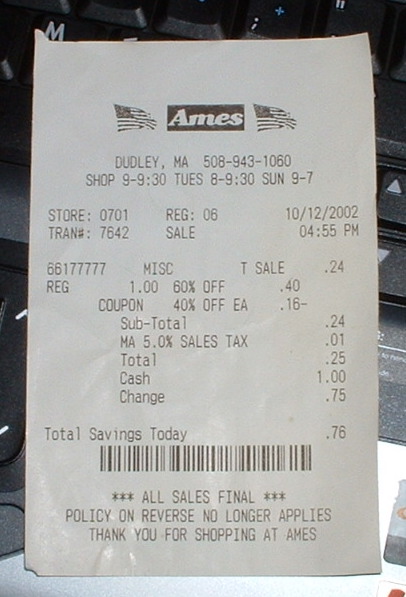
Even in the final days of “Bargains By The Bagful”, Ames was still using the eight digit SKU numbers from days of yore.
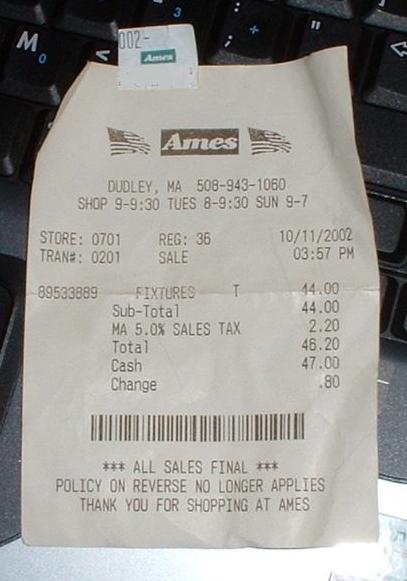
I have to wonder if Ames still had any candy bars in stock in those final days, if the cashier would have entered 67235515 on the Siemens-Nixdorf or IBM SurePOS terminal running the Cornell-Mayo Associates software.
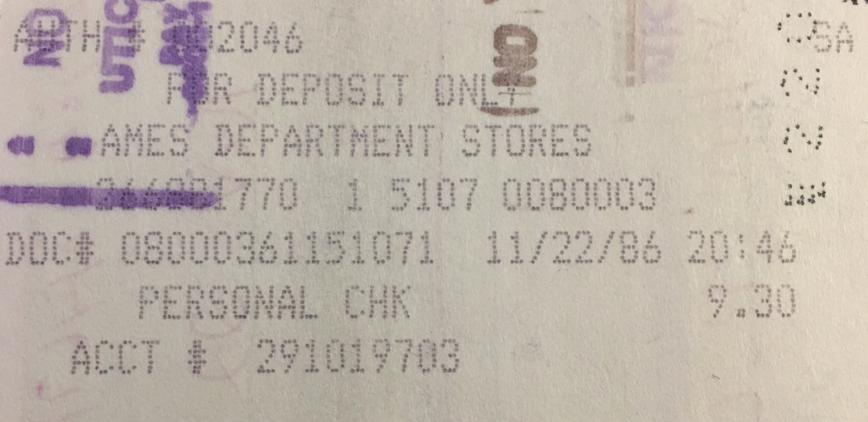
As mentioned in the previous post, before the Zayre acquisition Ames was fully committed to the IBM 3680 Programmable Store System. Each receipt was marked with a two line header identical to the third and fourth line of the check endorsement shown above. Per my research the DOC # was unique to Ames; other stores using the same system would feature only the transaction number, store number, and cash register number in the header. The DOC # was all of this information, plus more, stored in one unique number for transaction.
After the Zayre acquisition, Ames brought their legacy IBM 3680 up to date and added scanning through a system called AWare/4680. AW Computer Systems of Mount Laurel, New Jersey wrote custom interfaces for legacy front end point of sale equipment to work with, at the time, the latest system offerings from IBM, the IBM 4680 Store System. Through AWare/4680, the IBM 3683 and 3684 cash registers used at legacy Ames stores was able to run the same software powering the newer systems running at the Zayre stores. In addition, AWare/4680 added scanning capabilities to the older IBM 3680 equipment.
I believe the IBM 3680 system ran on some back office minicomputer of some sort. The IBM 3684s up front had the capability of running one or two IBM 3683s connected to it; the 3683 did not have a floppy drive but the 3684 did have an 8-inch floppy drive. Once in a while you’d hear that make typical floppy drive sounds of the day.
The AWare/4680 replaced the back office computer with two IBM PS/2s running IBM 4680 OS as the host operating system. AWare/4680 acted as an interface between the newer host OS and the older point of sale equipment up front. Another installation of AWare/4680 allowed the grocery chain Safeway to run IBM 4680 OS Supermarket Application to power their stores, while using older Datachecker point of sale terminals up front.
When Ames moved the legacy stores from IBM 3680 Programmable Store System to the AWare/4680 solution, the registers were reconfigured with several keyboard modifications (for example, “CASH TEND” was moved from the ENTER key to a key in the next row over, in the same position as on the IBM 4683 registers in former Zayre stores), changes to the guidance panel (transaction selection changed, no need to hit “MODIFY TICKET” to start a cash transaction), and the receipt layout was changed to longer item description, the replacement of the “Ames” logo to AMES in all capital letters, and the standard transaction identifiers of transaction number, store number, and register number. The long DOC # and two line receipt header were gone.
Using AWare/4680 allowed Ames to use the same front end equipment for around 15 years.
Honestly, I think that’s pretty amazing.
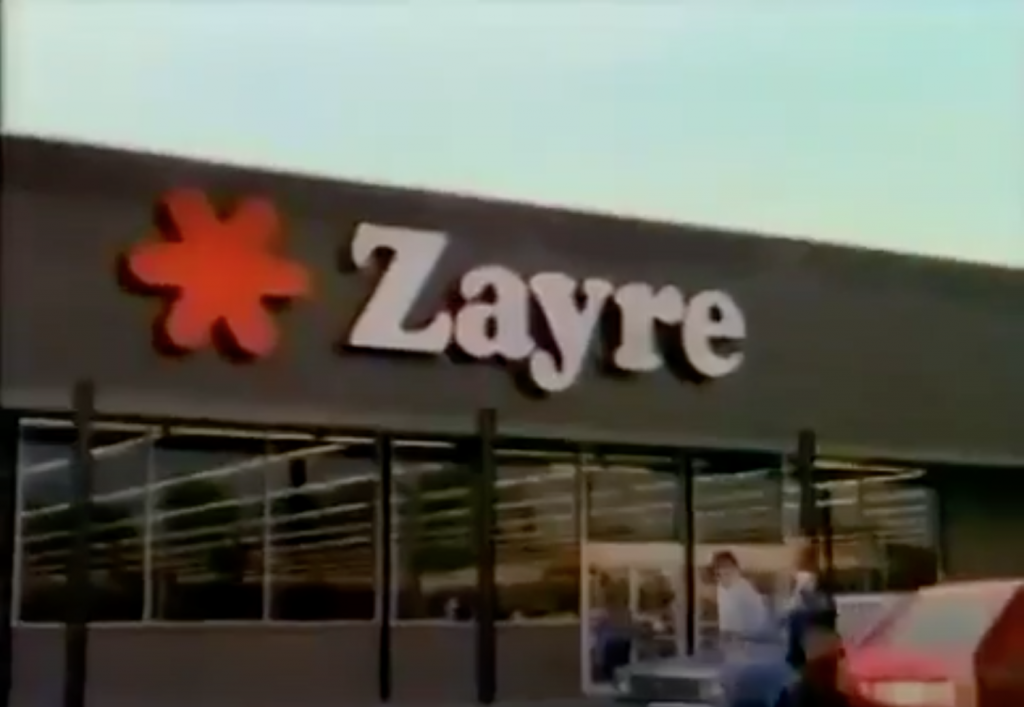
In the late 1970s, the Framingham, Mass. based Zayre Discount Department Stores renovated all of their stores to a new “orange and brown” decor, complete with an orange asterisk and a mixed case logo, the last logo that would be used with the department store chain. At the time, like other department stores of the era, Zayre was using Sweda Model 46 cash registers with inventory control capabilities. The registers would punch inventory information on optical tape and the tape would be sent to the main office to be fed into a mainframe. Zayre used two digit department numbers for tracking purposes.
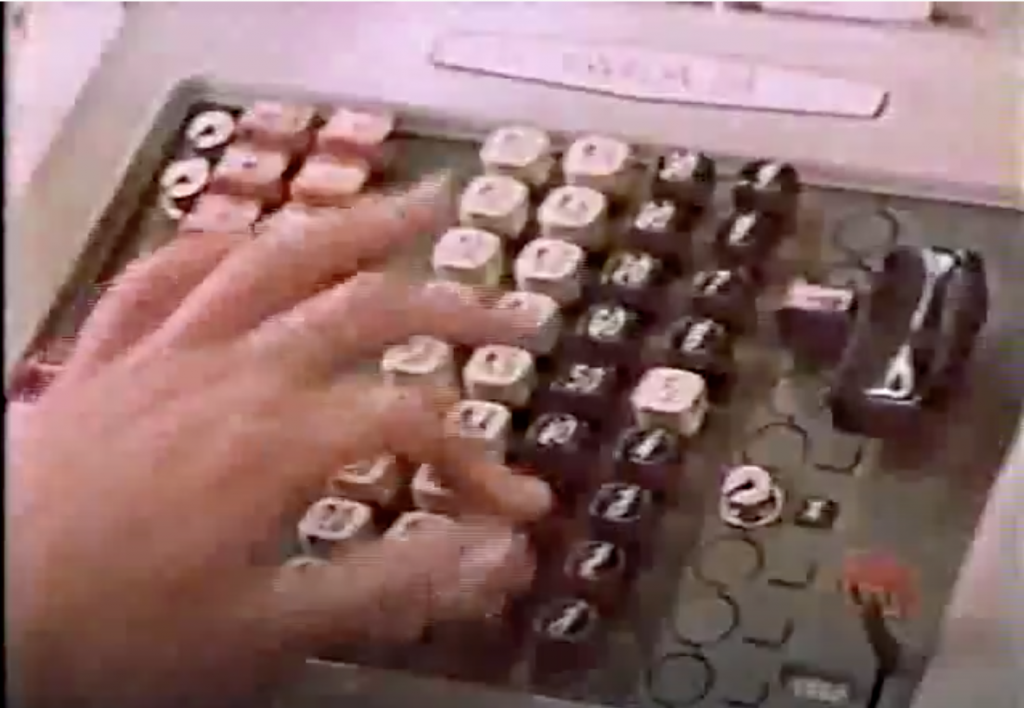
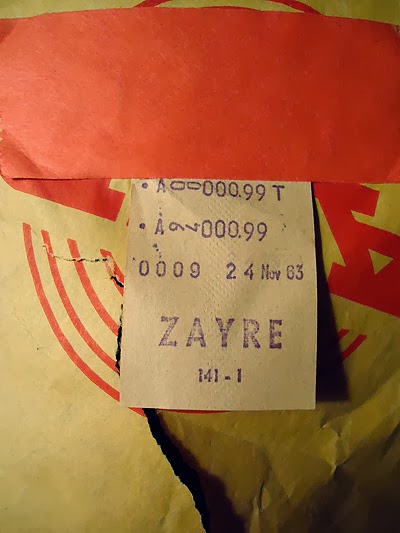
In the early 1980s Zayre moved into the electronic era but in a seemingly unified way. While several other discount chains were using a mix of point of sale systems (for example, Kmart used a mix of NCR, IBM, and Data Terminal Systems at the time), Zayre moved to NCR 2552 cash registers up front with a pair of NCR 726 minicomputers in the back. Zayre opted to use the NCR 2552s in a “distribution fashion”: the cash drawer was mounted under the checkout counter that faced the customer, the printer (with three print stations: receipt, journal, and form) sat where the entire cash register would normally sit in a traditional checkstand setup, and the keyboard and display were mounted on a pedestal at the corner of the checkstand. Unlike the IBM 3680 Programmable Store System at the time, the NCR 2552 (and its older counterpart, the larger NCR 255) used a standard keyboard layout. Many of the keystrokes required for a Zayre transaction would mirror the same keystrokes for the same transaction at a Hills store using the same equipment. Unlike the older NCR 255s, the NCR 2552s allowed the cashier to see numbers on the display as they were entered into the cash register.
Like on the Sweda mechanical cash registers, Zayre used two-digit department numbers. Further inventory control was maintained by a four digit “Style” number. “Generic” entries, like a candy bar in department 91 but without a “style” (or SKU) number, would be entered with the department number repeated twice as the style, so candy bar would be entered 91 [DEPT/STYLE] 9191 [DEPT/STYLE], the function key being to the left of the number pad.
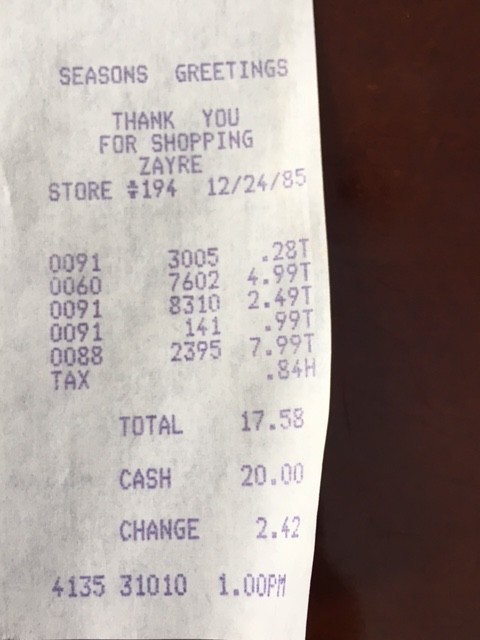
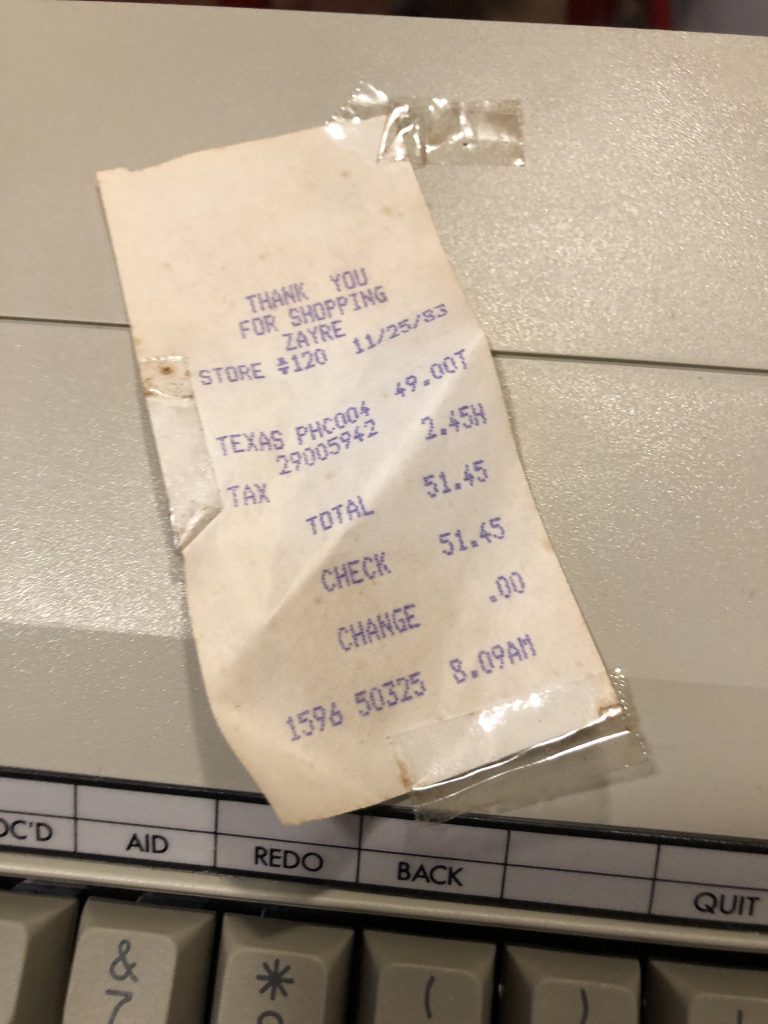
In 1988 Ames Discount Department Stores purchased the approximately 400 stores in the Zayre chain. After closing about a fifth of those stores, Ames began the task of converting the Zayre locations to new systems. At the time Ames was still using the IBM 3680 Programmable Store System, a system no longer manufactured by IBM, as IBM had introduced IBM 4680 OS, the IBM 4683 and 4684 cash registers, and General Sales Application. Without 3680 hardware available, Ames decided to go ahead and install the IBM 4680 system in 315 former Zayre stores… in 120 days in 1989. The reasoning for the move was the Zayre NCR system didn’t do what Ames wanted it to do and the IBM 4680 system would be fine since at the time, the stores didn’t communicate with one another.
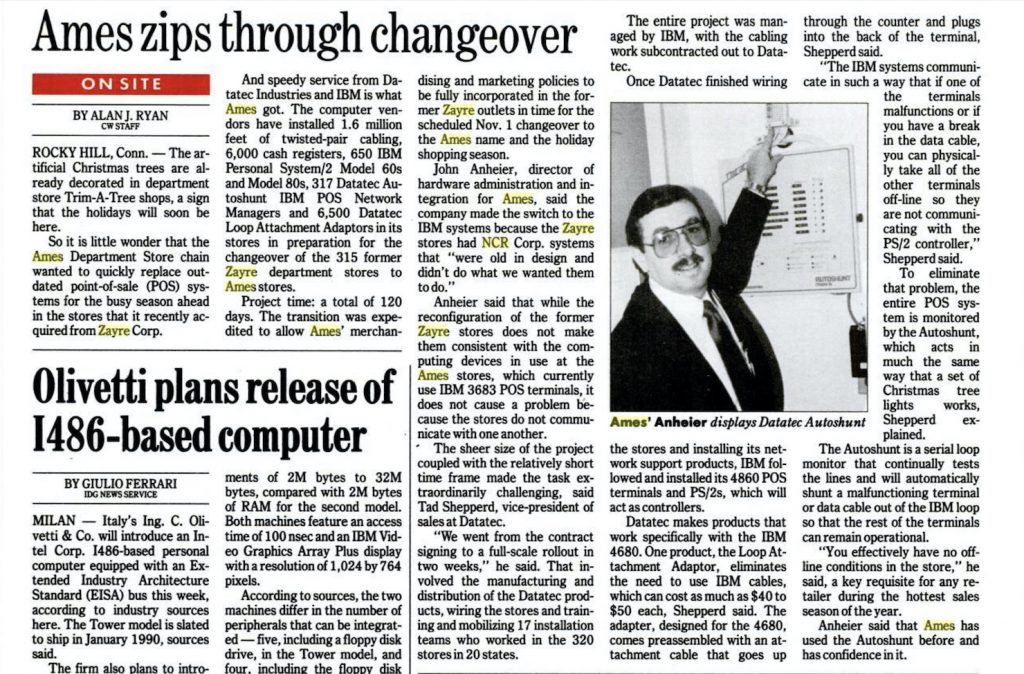
Ames sent training coordinators to the Zayre location, advising them they were now going to be training on IBM 4680 GSA and the learn the system. General Sales Application was modified to work a lot like the IBM 3680 Programmable Store System that was in use at the legacy Ames stores, and while GSA was designed for scanning, Ames opted to not use scanning.
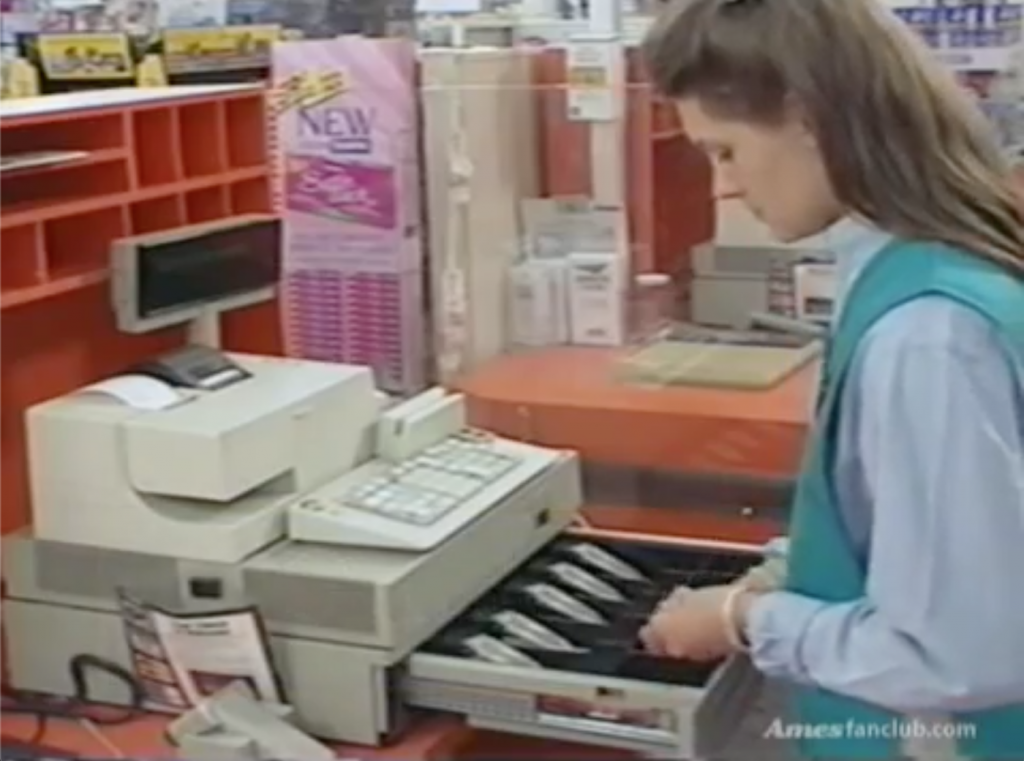
When Ames implemented the new registers for the change over from Zayre to Ames there was a mix of inventory marked with Zayre pricing information while others were marked with Ames stickers. The new IBM 4683 registers had a similar keyboard layout to the IBM 3683s at the legacy stores. The “SKU” button was actually labels “AMES SKU”. Zayre department and style information was entered as DD00SSSS where the two digit department number was followed by two zeroes and then the four digit style number. The cashier then pressed ENTER instead of SKU, before entering the quantity and/or the amount of the item.
At the time, Ames was using the slogan “It pays to shop at Ames Everyday!”. Before Zayre stores were converted to the Ames nameplate but after the registers had been changed over the new system, receipts printed “It pays to shop at Zayre Everyday!”.
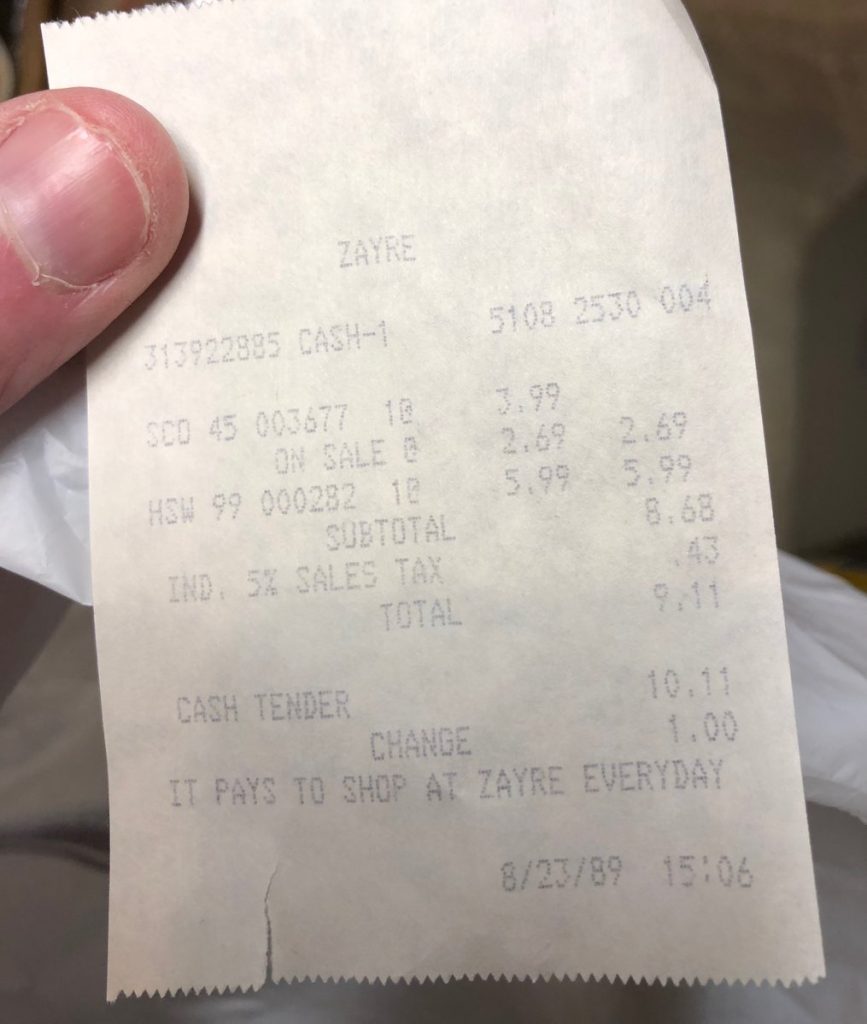
The layout of the Zayre receipt is similar to what Ames used on the IBM 3683 systems, with the exception of the header and footer information, which matched the typical General Sales Application layout. At the top of Bradlees, Walmart, and other chains using the same system at the time you’ll see the “CASH-1” designation.
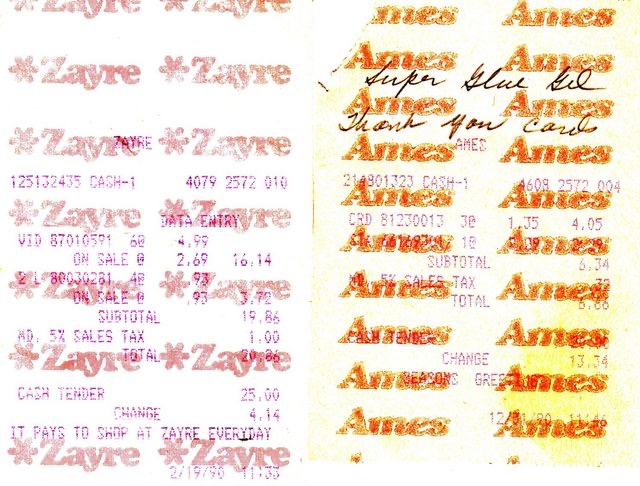
The way you can tell the difference between the 3683s and the 4683s is also the tender information being left justified and the print quality being (surprisingly) not quite as good as found on the older machines.
Customer feedback during the changeover conveyed frustration with the new cash register system at the former Zayre locations, as they were slower than the older NCR systems they replaced.
Ames officially changed the Zayre stores over to their new nameplate in November 1989 (though some of my research disputes this as well). The receipt footer was modified to It Pays to Shop At Ames Everyday with an extra space between “At” and “Ames”, where Zayre had been five characters long.
Scanning would be introduced a short while later, at first with the newer IBM 4683 General Sales Application registers at the former Zayre locations, followed by a significant upgrade to the older IBM 3680 registers. The older registers would get a new keyboard layout and workflow, and the “Ames” logo at the top would disappear in favor of the standard “AMES” in all caps. Curiously, the store in my hometown (store #80) printed the store address at the top of the receipt as well, but I didn’t see this at other locations.
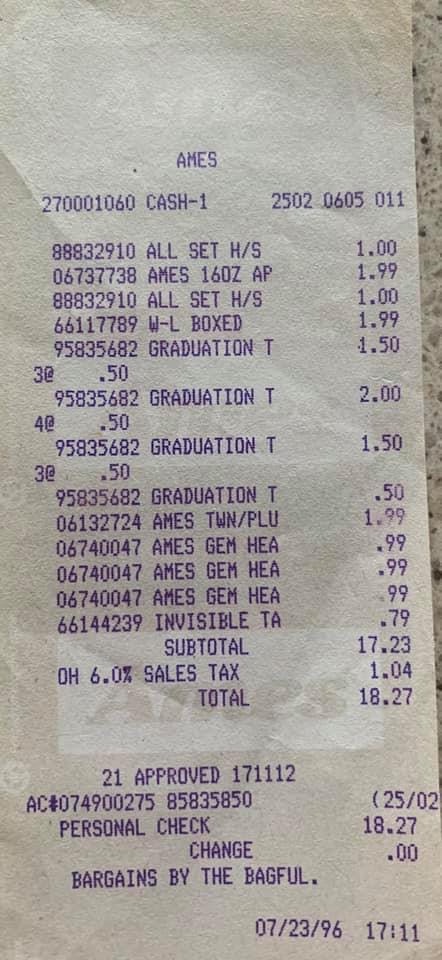
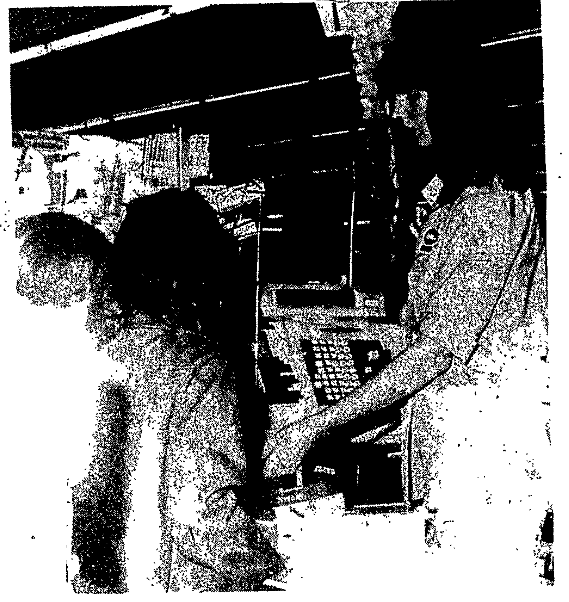
In the early 1980s (still researching the year), our local Ames was upgraded from mechanical Sweda cash registers to the IBM 3680 Programmable Store System. Our family was visiting this Ames on a roughly weekly basis. At the time layaway was handled up front at the Service Desk. The Service Desk normally had two Sweda Model 76 cash registers, one for refunds and one for layaways. Larger than the counterparts found at the regular checkouts, the Model 76 registers had more administrative buttons and printed receipts on double wide paper. The Model 76 registers could also print on forms, something the registers at the checkouts couldn’t do. Even though this Ames location had been open only a couple of years, the store had already outgrown the four checkout lanes and additional registers were on the end of the checkstands. During busy times the store would move two customers through one checkout lane at the time, one working at the normal register location, the other working on the end of the check stand.
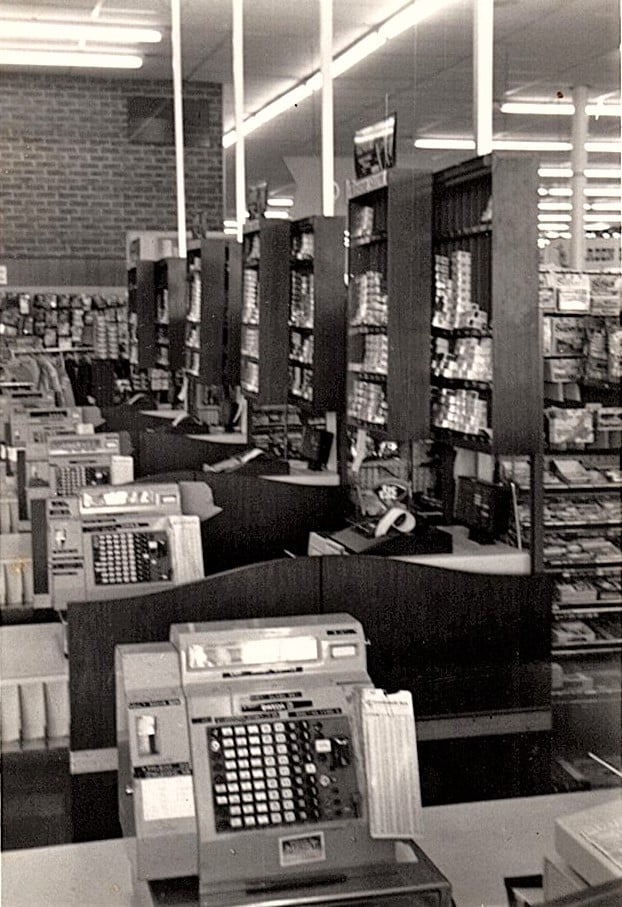
But back to the service desk. The geek in me immediately noticed a new IBM 3683 cash register installed between the two Sweda Model 76s. Powered up but with nothing on the customer facing display, this register wouldn’t be used for customers for a little while. Once in a while I’d see a person working on this new IBM register, but they didn’t seem to be assisting customers at the time, but rather just entering information from various paperwork.
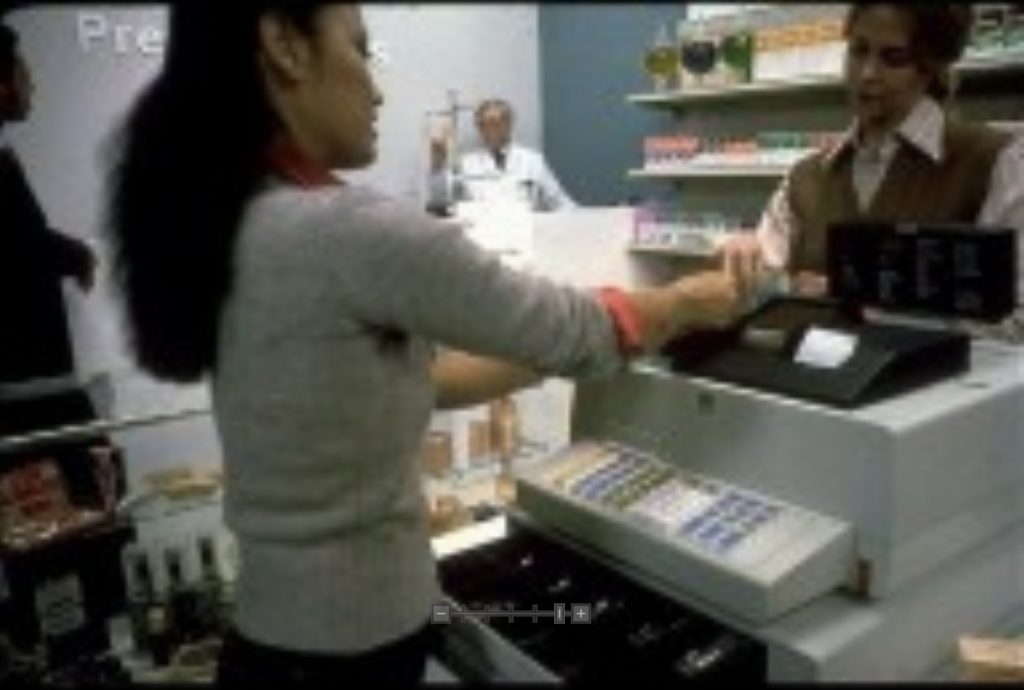
I believe data entry was taking place in preparation for the impending conversion to electronic point of sale systems.
Our family was visiting towards the end of business hours on a Saturday when it was clear changes were taking place with the installation of new cash registers throughout the store. An IBM 3683 terminal was already sitting on the jewelry counter, the Sweda cash register was gone. There were boxes of equipment marked “IBM” below the checkouts. I recall overhearing a woman ask the manager of the store, “what are the registers on the end of the checkouts”? The manager replied, “I keep a couple extra around in case one of these registers break down.”
Curious about the IBM register sitting on the jewelry counter, I walked by slowly to take a look. There was receipt paper hanging out of the register; it looked like a tech was doing some testing. This was the first time I saw the Ames logo printed on a register receipt.
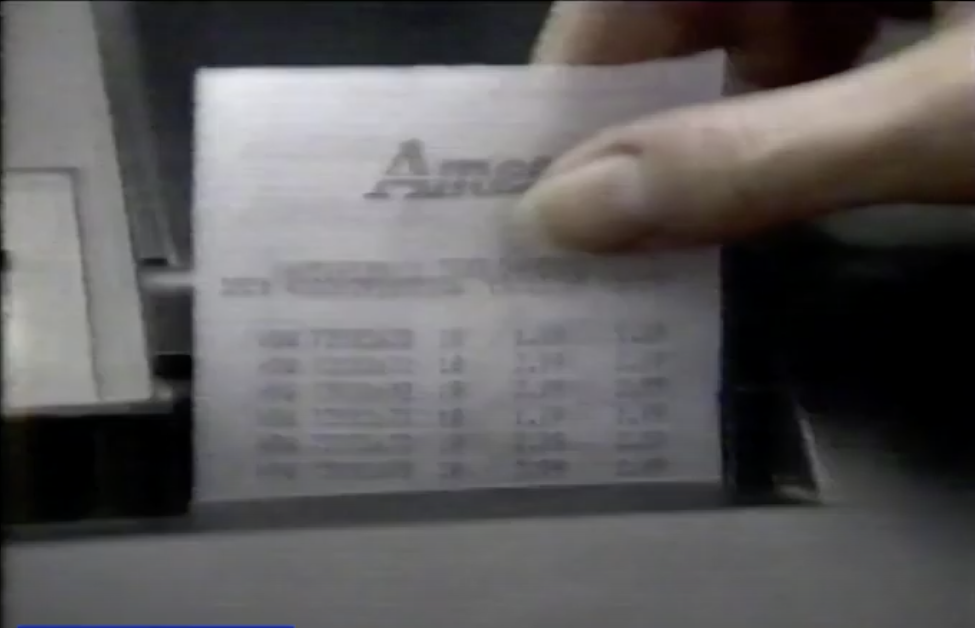
I was excited to know the next time we went to Ames they’d probably be using these new IBM machines that were being unboxed and installed.
It would take a few visits for me to get to know the functionality of these machines by sight and sound. I would take notes, look at receipts, and try to figure out what was going on. Scanning was still in its infancy and most relegated to supermarkets at the time. Ames went with an eight digit SKU (stock keeping unit) system, which was entered by hand, followed by the item amount.
The keypad was calculator style, with 7-8-9 along the top. CLEAR was a double-height key on the first left-hand column of keys, in parallel with the zero and 1-2-3 rows. To the right of CLEAR was Modify Ticket. SKU was to the right of the number pad, parallel 7-8-9 and the function keys above the number pad, QTY below that, and ENTER / CASH to the right of 1-2-3 and the zero row. Tender keys were to the right of these keys, with SUBTOTAL and TOTAL all the way on the right in the lower two right hand positions of the keyboard.
Like some cashiers on the Sweda mechanical cash registers, some pressed SUBTOTAL then TOTAL, others just pressed TOTAL.
When the IBM 3680 system was first brought to Ames #80 the cash drawer wouldn’t pop open immediately after the cashier hit the type of tender key, a few lines of the receipt would print first, then the drawer popped open. This was changed within the first year of the system being adopted here, where the drawer opening was moved to be instantly after the CASH tendered key was pressed. This was the way it was when I worked at another Ames store in the late 1980s.
One function that seemed to trip up cashier quite a bit was having to select the type of transaction for every sale. Curiously, Ames cashiers had to press the MODIFY TICKET key to start a sale, when the TRANS TYPE light was illuminated on the display.
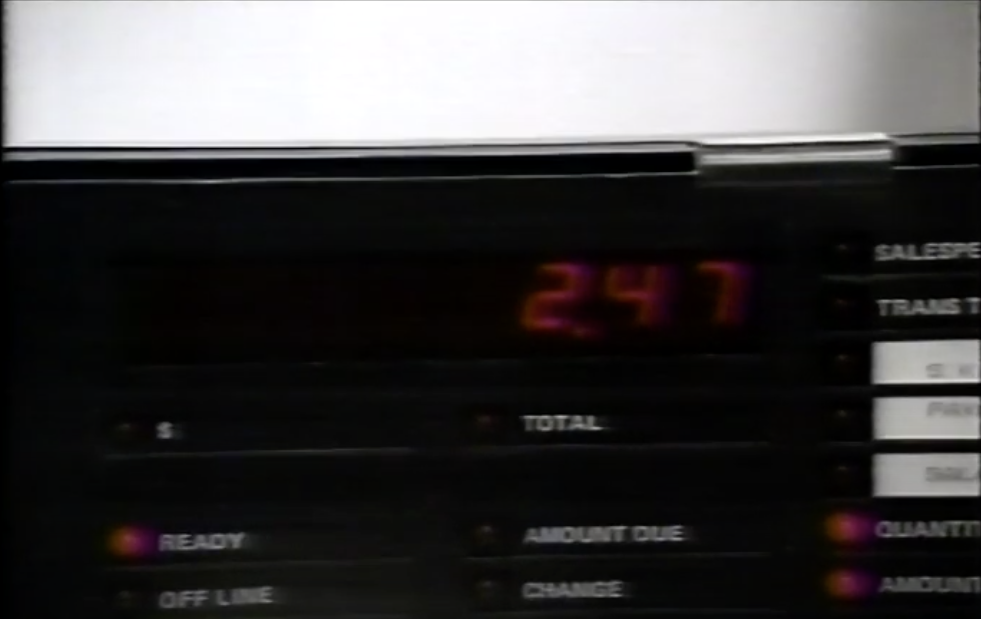
While I have yet to locate documentation for the IBM 3680 Programmable Store System, the early IBM 3650 Programmable Store System also had a Modify Ticket key, which was used by cashiers to indicate they wanted to change the price on a “wanded” item. Normally, when TRANS TYPE was illuminated, a cashier would have pressed “1” for CASH SALE, but for some reason Ames decided to use the Modify Ticket key for this.
It would be a few years before the registers would have the capability of knowing an item price by SKU. Originally the registers would know if an entered price was too low or too high for the entered SKU. This was based on the first three digits, which was the class number of the item.
Ames’ eight digit SKUs were all based on the original two-pass class/SKU entries on the older mechanical registers, and many items were marked with both during the transition to the IBM system. Whereas the punch tape version used a three digit SKU, four digit SKUs were introduced with the conversion; one can assume it was to accommodate chain growth. Hence, the SKUs introduced in the IBM conversion were actually the three digit class + a four digit SKU + one digit as the Modulus 10 checksum digit. For example, a price ticket would have a top line of 112 237, second line of 23701121, and then the price. On the Sweda register, pass one would be 112, pass two would be 237.
Entered SKUs had to pass the Modulus 10 check unless they were “generic” SKUs, which was the class number padded with zeroes. I believe the registers were not validating an entered SKU on the backend, rather, it was making sure it passed the modulus 10 checksum. At first it looked like cashiers had to “fill up the screen” with zeroes when entering generic SKUs. Before candy bars were 67235515, they were originally entered as 67200000. The LED display on the register held eight digits at a time; longer numbers (like credit card numbers) would simply scroll off the screen as they exceeded the width of the display. In later years, cashiers could pass a generic SKU with 7s instead of zeroes.
The one thing I could never reverse engineer from the receipts was all of the data included in the “DOC #” at the top of a receipt. Like other point of sale systems of the time, the receipt contained the store number, the transaction number (usually four digits), the cashier ID number, and the date and time. But Ames also printed a DOC #, which restated all this information, along with other information, in one long numeric string.
A typical DOC # would be something like 08000116512346, where:
When Ames acquired Zayre in 1989 and began replacing their NCR 2552 registers with IBM 4680 General Sales Application, the receipts were much more like other stores using IBM 4680 at the time and they didn’t include the DOC # like the 3680 PSS registers did. However, a layaway transaction at a former Zayre location did use the same scheme for the Layaway Account Number.
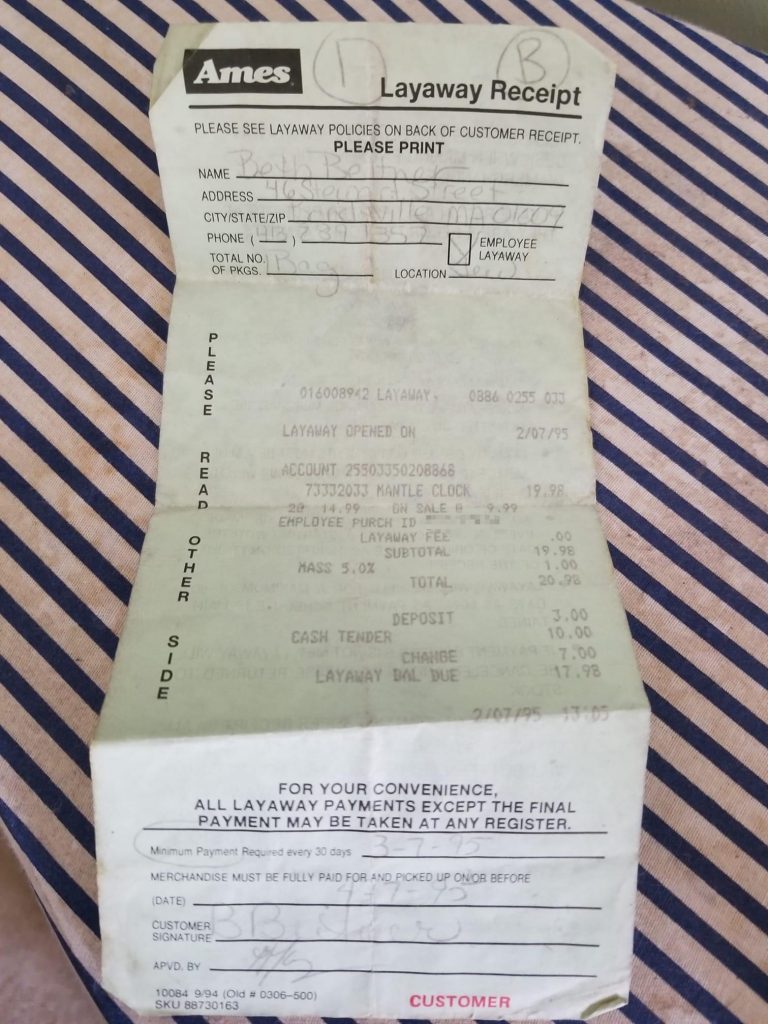
It was Ames #80’s migration to the IBM 3680 Programmable Store System that kicked my interest in computers, point of sale systems, and software engineering into high gear. When I worked a few months around the holidays at another Ames store in 1989, Ames was pretty much still using the same software with a few upgrades here and there.
It would be a couple more years before Ames would add scanning to the 3680 Programmable Store System.